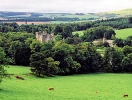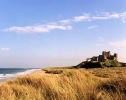- Belfort holiday
- Hits: 982
- Downloads: 0
-
Description:
Anyone visiting Northumberland will be tempted to take the boat trip from the nearby fishing port of Seahouses out to the Farnes. Whether a short trip round Inner Farne, or a longer excursion landing on some of the islands, it is well worth doing.
The bird life is spectacular. Thousands of pairs of puffins, guillemot, kittiwake, arctic tern, eider duck and many other species breed here. Although visitors, quite rightly, are not at liberty to roam at will, it is still possible to observe the birds at close range from certain positions above the cliffs and photographic opportunities abound.
There is also a colony of Atlantic grey seals who observe their visitors with a calm, detached curiosity. This one popped up by chance as I tried to line up my horizon for a seaward view of the castle.
- Belfort holiday-5
- Hits: 939
- Downloads: 0
-
Description:
There is a very nice and gentle day's walk south from Seahouses to the next village of Craster; especially nice if you stop off for lunch at the pub in Low Newton-by-the-Sea and allow your lunch to digest at the nearby bird sanctuary. Eventually the path will bring you to Dunstanburgh Castle.
The first time I saw this castle was many years ago from the south. I was supervising a party of teenagers and the plan was to try and use up some energy in a brisk, late evening walk to the castle, before inflicting them on the other residents of the hostel. With the summer sun setting well to the north the castle presented a dramatic, even sinister silhouette, looking for all the world like a set of rotting teeth. This image taken in daylight shows a gentler aspect.
The castle was constructed in 1313 by Thomas the Earl of Lancaster as his stronghold and seat of power against competing barons, also as a defense against the Scots who were frequently raiding from the north. Additions were made in subsequent years when its ownership passed to John of Gaunt. His son became King Henry IV, so it became a royal castle.
During the Wars of the Roses it was besieged and was starved into surrender in 1462. After this, with effective cannon available to any attacker, it fell rapidly into decay and it ceased to be habited sometime in the sixteenth century.





